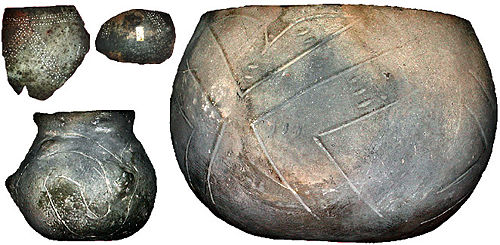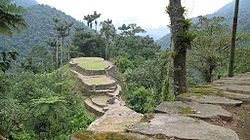
Archaeological sites in Colombia
Encyclopedia

Paleolithic
The Paleolithic Age, Era or Period, is a prehistoric period of human history distinguished by the development of the most primitive stone tools discovered , and covers roughly 99% of human technological prehistory...
, representing different aspects of the various cultures of ancient precolumbian civilizations, such as the Muisca
Muisca
Muisca was the Chibcha-speaking tribe that formed the Muisca Confederation of the central highlands of present-day Colombia. They were encountered by the Spanish Empire in 1537, at the time of the conquest...
, Quimbaya
Quimbaya
Quimbaya is a Pre-Columbian term. It may mean:*The Quimbaya civilization of western Colombia*Quimbaya, Quindío, a municipality in the department of Quindío in Colombia*Quimbaya, an extinct Choco language...
and Tayrona among many others. Preservation and investigation of these sites are controlled mainly by the Ministry of Culture
Ministry of Culture (Colombia)
The Ministry of Culture is the national executive ministry of the Government of Colombia charged with preserving, promoting, and encouraging the growth, free expression and understanding of the Culture of Colombia in all its multi-ethnic forms.-Ministers:...
, the National Institute of Anthropology
Anthropology
Anthropology is the study of humanity. It has origins in the humanities, the natural sciences, and the social sciences. The term "anthropology" is from the Greek anthrōpos , "man", understood to mean mankind or humanity, and -logia , "discourse" or "study", and was first used in 1501 by German...
and History, and the Bank of the Republic
Bank of the Republic (Colombia)
The Bank of the Republic is the state-run central bank of the Republic of Colombia. Its main functions are detailed by the Congress according to the . One of them is the issuance of the Colombian currency, the peso.-History:...
. The lack of funding to protect sites and enforce existing laws, results in large scale looting and illegal trading of artifacts.
Sites
| Year | Period | Site | Image |
|---|---|---|---|
| 15000 BC-10000 BC | Pleistocene Pleistocene The Pleistocene is the epoch from 2,588,000 to 11,700 years BP that spans the world's recent period of repeated glaciations. The name pleistocene is derived from the Greek and .... |
El Abra El Abra El Abra is an archaeological excavation site, located in the valley of the same name, east of the city of Zipaquirá, department Cundinamarca, Colombia; in the Altiplano Cundiboyacense, at an altitude of 2,570 m... |
|
| 6000-5000 BC | Neolithic Neolithic The Neolithic Age, Era, or Period, or New Stone Age, was a period in the development of human technology, beginning about 9500 BC in some parts of the Middle East, and later in other parts of the world. It is traditionally considered as the last part of the Stone Age... |
Monsú and Puerto Hormiga archaeological site Puerto Hormiga archaeological site The Puerto Hormiga archaeological site is located in the Bolivar department, Colombia, on the Atlantic coast. It has an uncertain date, between 4000 and 12,000 BC.... . |
 |
| 2500 BC-1500 BC | Muisca Muisca Muisca was the Chibcha-speaking tribe that formed the Muisca Confederation of the central highlands of present-day Colombia. They were encountered by the Spanish Empire in 1537, at the time of the conquest... formative stage Formative stage The Formative Stage or "Neo-Indian period" is an archaeological term describing a particular developmental level. This stage from 1000 BCE to 500 CE is the third of five stages defined by Gordon Willey and Philip Phillips' 1958 book Method and Theory in American Archaeology.Cultures of the... |
El Infiernito El Infiernito El Infiernito , is a pre-Columbian Muisca site located at the outskirts of Villa de Leyva, Boyacá Department, Colombia. It is composed of several earthworks surrounding a setting of menhirs ; several burial mounds are also present... |
 |
| 1600BC- 500BC | Delayed Cacical | El morro del tulcán El morro del tulcán El Morro del Tulcán is an Indian pyramid in Popayán, Colombia. The pyramid dates to at least 1535, as the Spanish found it abandoned when they arrived in that year... |
 |
| 600BC- 300AD | Formative Sinu Malagana-Sonsoid | Malagana Malagana Malagana, also known as the Malagana Treasure is an archaeological site of Colombia named after the same name sugarcane estate where it was accidentally discovered in 1992... |
|
| 800 BC | Early Tayrona | Ciudad Perdida Ciudad Perdida Ciudad Perdida is the archaeological site of an ancient city in Sierra Nevada, Colombia. It is believed to have been founded about 800 AD, some 650 years earlier than Machu Picchu... |
 |
| 200 BC | Classic San Agustin | San Agustín San Agustín, Huila San Agustín is a town and municipality in the southern Colombian Department of Huila. The town is located 227 km away from the capital of the Department, Neiva. Population is around 30,000. The village was originally founded in 1752 by Alejo Astudillo but attacks by indigenous people destroyed... |
 |
| 200 BC- 600AD | Classic Tierradentro | Tierradentro Tierradentro Tierradentro is a National archeological park in the jurisdiction of the municipality of Inza, Department of Cauca, Colombia. The park is located 100 km away from the capital of the Department, Popayán.... |
 |

